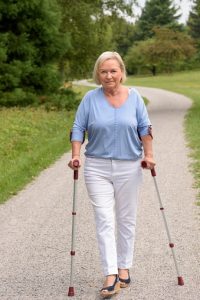
Researchers worked with volunteers who had suffered strokes seven to 17 months prior to the study. They taught them moderate intensity arm cycling exercises, which they did three times a week for 30 minutes over a period of five weeks.
To assess the effect of the exercises, researchers tested the walking abilities, electrical activity, and stretch reflexes in the lower leg and wrist muscles. This was done before the training sessions began, during the study, and after the five weeks.
Walking tests included the following:
- A six-minute walk where distance covered was measured.
- A timed 10-meter walk to measure speed.
- Another test called Timed Up and Go measured the time taken for a seated person to stand up, walk 10 feet, return, and sit again.
Researchers observed that arm exercises helped the volunteers improve their performance in all the walking tests. However, the most improvement (up to 28 percent) was seen in their performance in the Timed Up and Go test. According to researchers, arm cycling training helped to activate the nerve networks that connected their limbs, allowing for better coordination. When the arm nerves were activated and adapted, the spinal cord function improved, which improved the functioning of the legs.
Muscle tests revealed that there were no major changes in the grip strength of participants. However, their muscles were more relaxed after they completed the arm exercises.
The experiment proved that arm exercises could be included in stroke rehabilitation to improve post-stroke leg function.
Other exercises to improve walking after stroke
Experts recommend several stroke recovery exercises that can help to improve gait (the manner of walking). These include foot exercises, leg exercises, and balance and core work.
Foot exercises can help improve the ability of stroke survivors to walk. They’d be better able to strike the ground with their heels, follow through, and use the toes to push the foot off the ground. Sample exercises that can improve these functions include heel raises, assisted toe raises, and ankle dorsiflexion with the help of the unaffected hand. Each of these should be repeated 10 times.
Leg exercises are essential to improve leg movement. They include knee extensions and seated marching, where the patient is advised to raise the affected leg to the chest and place it back while being seated. To make them more challenging, patients can pause for a second or two when the leg is above the floor.
Core training includes toe taps and knee-to-chest exercises that are done in a lying-down position. These exercises help to strengthen and engage the core muscles while walking to improve gait.
Flamingo stands (standing on one leg for 30 seconds and repeating with the other leg) and side leg raises (about 45 degrees to each side) help to improve balance.
Leg exercises, core training, and balancing exercises require 20 repetitions (10 for each leg) to be effective.
Stroke recovery is a long process that involves stroke rehabilitation through exercises to improve walking. Toe exercises, leg exercises, core training, and balancing exercises help to strengthen the muscles and improve their movement. These are typical stroke recovery exercises as they help to improve gait. However, due to lack of coordination and damage to nerves, complete recovery in walking ability is not possible unless the nerve connections that help to coordinate the movements function better. The latest research proves that this can be achieved through moderate intensity arm cycling exercises.